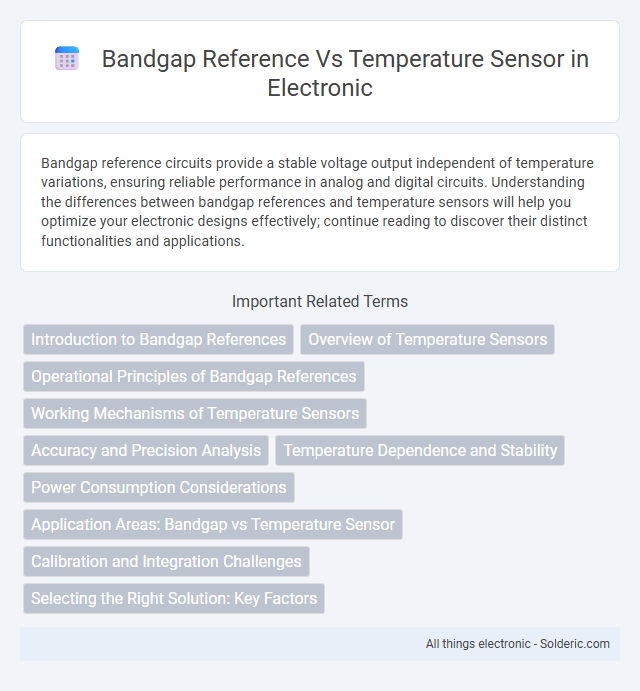Bandgap reference circuits provide a stable voltage output independent of temperature variations, ensuring reliable performance in analog and digital circuits. Understanding the differences between bandgap references and temperature sensors will help you optimize your electronic designs effectively; continue reading to discover their distinct functionalities and applications.
Comparison Table
| Criteria | Bandgap Reference | Temperature Sensor |
|---|---|---|
| Primary Function | Provides a stable voltage reference independent of temperature | Measures and outputs temperature data |
| Output | Constant voltage (~1.2V) | Temperature-dependent voltage, current, or digital value |
| Operating Principle | Combines PTAT and CTAT voltages for temperature stability | Relies on temperature-dependent semiconductor properties |
| Usage | Voltage reference in ADCs, DACs, power supplies | Thermal monitoring, control, and compensation |
| Temperature Dependence | Minimized to provide stable output | Highly dependent for accurate temperature measurement |
| Output Type | Analog voltage | Analog or digital signal |
| Accuracy | High voltage accuracy with low drift | Depends on sensor type; typically less precise voltage but calibrated for temperature |
| Examples | LM4050, MAX6033 | LM35, TMP36, DS18B20 |
Introduction to Bandgap References
Bandgap references provide a stable voltage output that remains consistent across temperature variations, making them essential for precision analog circuits. Unlike temperature sensors, which measure changes in temperature, bandgap references generate a temperature-independent reference voltage based on silicon's inherent bandgap energy. Your electronic designs benefit from accurate, reliable voltage stability when incorporating bandgap reference circuits.
Overview of Temperature Sensors
Temperature sensors measure thermal variations by detecting changes in physical or electrical properties caused by temperature shifts. Bandgap reference circuits provide a stable voltage output that is relatively insensitive to temperature fluctuations, making them essential in calibrating and compensating temperature sensors for accurate readings. These sensors utilize semiconductor properties, enabling precise and reliable temperature monitoring across various electronic applications.
Operational Principles of Bandgap References
Bandgap references generate a stable voltage output by combining the voltage across a diode junction with a complementary-to-absolute-temperature (CTAT) voltage, achieving temperature compensation near room temperature. The core operational principle relies on the predictable physics of silicon bandgap energy, maintaining a constant reference voltage typically around 1.25 V regardless of temperature variations. This temperature-independent output is critical for accurate analog circuits, enabling reliable voltage references in temperature sensors and other precision applications.
Working Mechanisms of Temperature Sensors
Temperature sensors operate based on changes in physical properties such as resistance, voltage, or current in response to temperature variations. Bandgap reference circuits provide a stable reference voltage largely independent of temperature, enabling accurate compensation in temperature measurement systems. Your choice between bandgap references and temperature sensors depends on whether you need precise voltage stability or direct temperature quantification through mechanisms like thermistors, RTDs, or semiconductor junctions.
Accuracy and Precision Analysis
Bandgap references deliver exceptional accuracy in voltage output by maintaining a stable reference with minimal temperature drift, typically achieving precision within +-1 mV over a wide temperature range. Temperature sensors, however, exhibit varying accuracy due to material properties and design, often requiring calibration to reach precision levels comparable to bandgap references, with common deviations around +-0.5degC to +-2degC. The intrinsic stability of bandgap references under temperature fluctuations makes them superior for applications needing consistent voltage benchmarks, whereas temperature sensors prioritize sensitivity over absolute accuracy.
Temperature Dependence and Stability
Bandgap reference circuits offer superior temperature stability by providing a nearly constant voltage output regardless of temperature variations, making them ideal for precision applications. Temperature sensors, on the other hand, rely on semiconductor properties that vary predictably with temperature, enabling accurate measurement but subject to inherent temperature dependence. Your choice between the two should consider whether you need a stable voltage reference or temperature-dependent output for sensing purposes.
Power Consumption Considerations
Bandgap references typically exhibit low power consumption due to their stable voltage output independent of temperature variation, making them efficient for precision applications. Temperature sensors, however, often require higher power to maintain accuracy and to operate components such as amplifiers or ADCs for signal conditioning. Balancing power consumption and accuracy is critical when integrating these components in battery-powered or energy-sensitive systems.
Application Areas: Bandgap vs Temperature Sensor
Bandgap references are crucial in precision voltage regulation within analog and mixed-signal integrated circuits, ensuring stable operation across varying temperature ranges in applications such as ADCs, DACs, and power management systems. Temperature sensors, on the other hand, are extensively applied in environmental monitoring, HVAC systems, and wearable devices to provide accurate thermal data for system control and safety. Your choice depends on whether stable voltage output or temperature measurement is the priority in your specific application area.
Calibration and Integration Challenges
Bandgap references require precise calibration to maintain voltage stability across temperature variations, which involves complex trimming processes to account for device mismatches and process variations. Temperature sensors face integration challenges due to their sensitivity to local thermal gradients and the need for accurate offset calibration to reduce measurement errors. Both components demand specialized calibration techniques and careful layout considerations to ensure reliable performance in mixed-signal integrated circuits.
Selecting the Right Solution: Key Factors
Selecting the right solution between a bandgap reference and a temperature sensor depends on accuracy, stability, and application requirements. Bandgap references provide precise voltage outputs with minimal temperature drift, ideal for voltage regulation and analog circuitry calibration. Your choice should consider the operating temperature range, required precision, and integration complexity to ensure optimal performance.
Bandgap reference vs Temperature sensor Infographic

 solderic.com
solderic.com